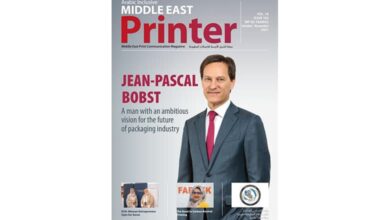It`S A Good Time To Look Out For Opportunities
Durst which is represented by Giffing Graphics put up a strong show during SGI.
We caught up with Christoph Gamper CEO of Durst to find out more about Durst solution for graphic arts industry and opportunities that are available for printers within large format printing sector.
 Durst has its roots in photography, do you believe that being a major manufacturer of large format printers today is a natural extension of your skills and knowledge in photography?
Durst has its roots in photography, do you believe that being a major manufacturer of large format printers today is a natural extension of your skills and knowledge in photography?
No! If not every company formerly working in photography would be now in Large Format. It is its own knowledge area even if some disciplines coming from photography are the same (physics, chemistry, high precision engineering). But it needed a lot more to be the player in the industrial inkjet field and Durst had to re-invent itself a couple of times.
Durst product portfolio is mind boggling. You are making printers for a variety of applications including posters, billboards, packaging, label, ceramic, textile, glass and so on. Isn’t it difficult to keep track of all the new trends?
We constantly and strategically develop new markets. Whenever we see a real benefit (cost, disruption, new application for our customer) of digital coming together with a certain opportunity we intensively research the process and the technology used today and create a model how it could look like if we do it and what the real benefit for the customer (and ourselves are). If all parameters fit the model, we create a team which explores the opportunity in a protected start up mode, only if successful a business unit (like a small company) gets created and is responsible to make the segment happen (including R&D, marketing, channels, promotion and so on). So even if it seems that we “play” in lot of fields the reality is that every move is carefully planned and prepared.
There are lot of buzz about latex printing, so far HP, Mimaki and I think some Chinese manufacturers have jumped on latex bandwagon, what is your take on this technology and are you planning to use this technology in near future?
I think water based systems will play a dominant role in the future of printing. We don`t need to jump on any train as in water based, textile decoration (direct to textile sublimation) we lead the quality market since the introduction of the first Rhotex platform 4 years back. For the rest pay us a visit at Fespa in Cologne. You will be surprised which solutions we are offering for the non UV world beyond soft signage and textile applications.
How important is Middle East market and how successful have you been in this region?
2014 was a good year for us in ME, and the market is very interesting to us for different reasons and different business units. In a nut shell I would say we had success, but there is lot more potential on both, the graphical and industrial printing side.
There are many large format manufacturers in the market what do you consider your core strength that sets you apart from the rest?
There are only a few playing in our league. I don`t want to praise ourselves but we are not investor but customer driven. We are in the market since more than 75 years. 100% family owned, and we re-invented ourselves several times to provide real value to our customers. My people is proud on what they are creating and we are doing this in a place where you would expect tourism, skiing and great food, but not high tech (the Tyrolean Alps). The addiction to technology and perfection of Durst people, combined with an owner family which has long term goals and is not short term investor driven, is the recipe for success and sets us apart. Every machine is designed with our customer and his customer in mind. That’s our reason to exist.
Is there any company that is selling your products on OEM basis? If not have you ever thought about this possibility?
No. And no. We will not give up control over sales and service. If you own a Durst printer you are part of the Durst Family. I do not want to dilute this with an OEM strategy.
In your opinion what are the future opportunities for large format print providers, soft signage, textile printing, packaging or industrial printing? Which of these segments are more promising?
Soft Signage has been a huge growth in some European countries and for sure it is a growth segment for the next years. As I already explained water based systems will play an important role for some application. As segments all the mentioned are interesting, but for textile/apparel the entry barrier is quite high (wet line, process). Packaging – to a certain extend – can be interesting , but even here, as with apparel there are entry barriers for pure large format providers, which need to be taken in consideration (process, people knowledge),
Do you think large format print providers should specialize in one specific area or they should be able to offer variety of applications, flexible, rigid, etc.?
I believe in diversification, but this really depends upon the business model of the large format provider himself. There are so many opportunities out there. Focus and dedication is the key. As well I have seen some business models where multiple former competitors teamed up to be able to provide together one stop solutions – everyone specialized and focused to his core competence.
You are also offering inks to your customers, are these inks your own products or they are OEM based?
We have our own research center in Lient (Austria) where we formulate organic, an-organic, water-based and functional inks. Once we formulated and fine-tuned we scale up with different providers. We are not an ink manufacturing company, but every batch of ink which we ship around the world has been passed our labs, and from this point on it’s a Durst ink, which guarantees the performance our customers expect and obtain.
What are the benefits of your ink and why should your customers use them instead of third party after market inks?
A perfect inkjet printing system is not made of one single component, but a come together of different disciplines – engineering, chemistry, physics or machine, heads, electronics, software, inks. Durst inks are fine-tuned by some of the finest chemists and physicist in the world and than run on our own test systems and machines before released to the market. Only with this we can guarantee the yield and output which sets our systems apart from the competition. There is no benefit after market inks for the customer. Maybe if price could be one at first sight, but if you lose productivity and uptime or even worse – heads due to chemical non-compatibility. We guarantee the systems with the highest uptime and performance in the market but to do so, we need to know on which “fuel“ the systems run and keep the chemistry at the same level as the systems are.
When I ask printers about Durst they say it offers good quality but it is expensive, do you like this kind of testimonial?
Yes and no. Question is, what is expensive? If you look into the Total Cost of Ownership and the Uptime and Versatility of a Durst printer and if afterward you still say expensive well, then it`s very probable that you are working a field we are not playing in. We produce with 100% respect for environment and people in the very heart of Europe, as explained before. This has a cost, but at the same time much more benefits attached to it.
Can you explain about Durst’s Quadro Array printhead technology? I assume it is proprietary technology, why you believe it offers better quality?
We do not just plug heads onto a beam and create a system from the shelf – let me start here. We manufacture every important piece in-house and design and code high-end data-paths, firmware and software. In almost 10 years of high-end inkjet we developed and patented a lot of technologies around the systems, taking profit from the experience in the different applications. On one hand we work closely with different printhead manufactures, on the other hand we combine heads into arrays. We customize into arrays (like the Quadro) and control firing frequency, drop mass and velocity to obtain (together with the right ink) unrivaled performance. Thousands of customers operating our systems and make a living with them prove us right.
You recently organized Durst Inkjet Corrugated Printing Days` in Lienz, and apparently it was a successful event do you think these kind of events offer you a better return on investment than trade exhibitions?
These are two different things.We still will invest and believe in trade-shows, as they are less specific and allow us to access an audience which maybe does not know Durst or has never seen a machine in operation. The”Printing Days” are on very specific topics like glass, textile, or corrugated and allow a much deeper discussion on the topic. Other relevant players in the workflow add their expertise as well and so the benefit for the customer is huge – unfiltered first hand information with “hands on“ on new technologies. Sometimes even on technology which is not on the market yet.
Do you think large format printing industry will capture a bigger share of packaging market in the future?
Difficult to say. Packaging is a huge market and highly diversified and some segments will never be accessible to non-specialists because of process know-how and investment barriers. Having said that there may arise some opportunity in small and medium runs where the digital advantage fits perfectly (fast design change, small run, personalization). Anyhow digital packaging is in baby-shoes. It`s a good time to look out for opportunities. We are here to support.




